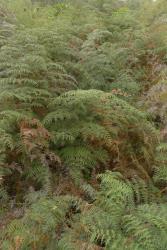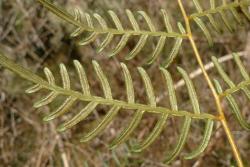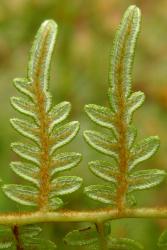Rhizomes long-creeping, 3–12 mm diameter, with stipes arising 10–100 mm apart; bearing red-brown, multicellular hairs up to 3 mm long. Fronds 250–2200 mm long. Stipes 85–1360 mm long, 1–10 mm diameter, becoming woody, grey-brown or pale chestnut-brown, glabrous or bearing scattered dark brown, multicellular, non-glandular hairs. Rachises pale chestnut-brown or yellow-brown, bearing similar hairs to the stipe up to 1 mm long. Laminae 2-pinnate-pinnatifid to 5-pinnate, broadly ovate or broadly elliptic, tapering to an undivided terminal segment, 100–1350 mm, 165–900 mm wide, adaxial surface dark green, abaxial surface paler green, coriaceous; abaxial lamina surface bearing abundant straight, white, appressed acicular hairs along the veins of ultimate segments; costae bearing curly brown, multicellular, non-glandular hairs up to 1 mm long, abundantly so in uncoiling fronds; adaxial surface of juvenile fronds bearing white, multicellular, non-glandular hairs, becoming glabrous in mature fronds. Primary pinnae in 7–20 pairs below undivided terminal segment, widely spaced proximally, overlapping distally, curled downwards, not winged, arising at 90° to rachis; distal primary pinnae ovate or narrowly ovate; proximal primary pinnae ovate or broadly ovate; the longest at or near the base, 70–820 mm long, 40–520 mm wide, apices acute, bases short- or long-stalked. Secondary pinnae decreasing gradually in length along primary pinnae to the distal end, except the basal basiscopic one usually greatly reduced to a stipule-like pinnule near junction with rachis, arising at 90° to costae; the longest narrowly to broadly ovate, 23–490 mm long, 5–200 mm wide, apices drawn out into an undivided terminal segment, bases short-stalked or sessile. Tertiary pinnae narrowly ovate, the basal basiscopic one sometimes reduced in highly divided fronds, arising at 90° to costae; the longest 3–115 mm long, 1–50 mm wide, apices drawn out into a long undivided terminal segment, bases short-stalked or sessile or decurrent in less divided fronds; decurrent segments sometimes becoming separated as free lobes. Quaternary pinnae narrowly oblong or linear, the longest 4–25 mm long, 1–10 mm wide, apices obtuse or rounded, margins entire, bases adnate or decurrent, divided again in largest fronds into ultimate segments up to 5 mm long and 1 mm wide. Ultimate segments up to 5 mm long and 1 mm wide. Sori almost continuous along margins of ultimate segments.
Note: measurements given above are from herbarium specimens. Much larger fronds are known to occur in the wild. CHR 223011 comprises parts of a frond that was said to measure 4700 mm long, with the stipe 2600 mm long, the lamina 2080 mm long, the largest primary pinna 1450 mm long, and the largest secondary pinna 560 mm long.
Pteridium esculentum subsp. esculentum can be recognised by its long-creeping rhizomes, highly divided laminae, with the pinnae and pinna segments arising at 90° to their axes, abaxial lamina surfaces bearing straight, white, appressed, acicular hairs along the veins of the ultimate segments and curly brown, non-glandular hairs on the costae, and sori that are more or less continuous around the lamina margins protected by the inrolled lamina margin and a poorly developed inner indusium. Fronds vary immensely in size from dwarf forms only about 200 mm long up to fronds 3–4 m in length, much longer than the dimensions given in the description above, which are based solely on herbarium specimens.
North Island: Northland, Auckland, Volcanic Plateau, Gisborne, Taranaki, Southern North Island.
South Island: Western Nelson, Sounds-Nelson, Marlborough, Westland, Canterbury, Otago, Southland, Fiordland.
Kermadec Islands, Three Kings Islands, Chatham Islands, Stewart Island, Antipodes Island.
Altitudinal range: 0–1000 m.
Pteridium esculentum subsp. esculentum occurs on Raoul Island (Sykes & West 1996), the Three Kings Islands, and in coastal, lowland, and montane sites throughout the North Island and much of the South Island. It has been under-collected from the driest parts of south Canterbury and Otago, where it is known to occur (John Steel, pers. comm.). In the North Island it grows from near sea level to over 1000 m in the northern Ruahine Ranges, and in the South Island up to 1000 m on Mt Benmore, Marlborough. It also occurs on Stewart Island, the Chatham Islands, and Antipodes Island.
Also Australia (Western Australia, South Australia, Queensland, New South Wales, Victoria, Tasmania), Lord Howe Island, Norfolk Island, Solomon Islands, New Caledonia, Vanuatu, Fiji, Tonga (see Brownsey 1989; Thomson 2012).
It has been reported from Mt Kinabalu (Parris et al. 1992; Beaman & Edwards 2007), and may extend to New Guinea, Indonesia, and Malaysia, but records are not clearly distinguished from P. semihastatum (Brownsey 1989). It has also been recorded for China, with a distribution extending to Cambodia, India, Indonesia, Malaysia, Philippines, Thailand, and Vietnam (Liao et al. 2013). In contrast, based on molecular evidence from three chloroplast DNA regions, Zhou et al. (2014) recognised only two subspecies of P. aquilinum in China. The exact distribution of P. esculentum subsp. esculentum outside Australia and the Pacific, especially in the Malesian region, therefore requires further investigation.
Pteridium esculentum subsp. esculentum is a serious weed of pasture, aggressively invading cleared or burnt land and forming extensive populations by means of its underground rhizomes (McGlone et al. 2005). It eventually disappears under regenerating scrub and forest. It is found in rough and reverting pasture, on road cuttings and banks, in ditches, on lake and forest margins, in peat bog, on old sand dunes, on cliff faces, in forest clearings and disturbed ground, along river beds and terraces, in tussock land, and on heated ground. Although mostly found in the open, it also occurs under podocarp, broadleaved and beech forest, under mānuka and kānuka, in coastal and other scrub and under pine plantations.
n = 52 (Brownlie 1954, 1957).
Bracken root was a staple plant food source for early Māori, second only in importance to the kūmara (Colenso 1881; Best 1942; Roskruge 2014), but was also valued for its medicinal properties (Riley 1994). The Ngā Rauropi Whakaoranga database, https://rauropiwhakaoranga.landcareresearch.co.nz, provides a comprehensive list of Māori names for the bracken fern and its various parts, and an extensive bibliography detailing its traditional use.














